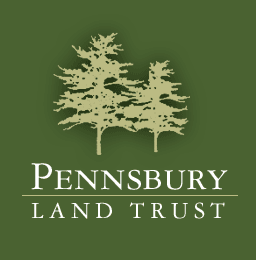Pennsbury Land Trust Meeting highlights case studies and return on investment to local economy
By Donna C. Gregory, Correspondent, UnionvilleTimes.com
 PENNSBURY — Kristine Kern, Bucks County’s open space coordinator and GreenSpace Alliance board member, made the case for preserving open space during the Pennsbury Land Trust’s annual meeting last week.
PENNSBURY — Kristine Kern, Bucks County’s open space coordinator and GreenSpace Alliance board member, made the case for preserving open space during the Pennsbury Land Trust’s annual meeting last week.
Kern presented two case studies from Chester County that demonstrate the economic value of open space. The studies are part of a larger study called “Return on Environment: The Economic Value of Protected Open Space in Southeastern Pennsylvania.” The first-time study encompassed Chester, Bucks, Delaware and Montgomery counties and Philadelphia, and was jointly commissioned by the Delaware Valley Regional Planning Commission and the GreenSpace Alliance, a nonprofit organization dedicated to preserving open space throughout southeastern Pennsylvania.
The Chester County’s Honey Brook Township and Hopewell Big Woods were cited as examples of how open space benefits the region economically. In Honey Brook, for example, it’s “estimated that the township’s 55 dairy farms and 2,145 cows generate nearly $29.5 million in economic activity every year,” reads the study. “More than two-thirds of Honey Brook’s 25 square miles are actively farmed.”
In 2005, Honey Brook residents passed a referendum to increase the township’s earned income tax to fund the preservation of farmland and open space. Since then, the township has “allocated nearly $4.5 million toward protecting agricultural land from development.”
The Hopewell Big Woods case study highlighted the environmental benefits of southeastern Pennsylvania’s largest unbroken stretch of forest. Hopewell’s 73,000 acres provide $47 million in annual environmental benefits, such as naturally cleaning the water and air and flood mitigation.
Homeowners also reap Hopewell’s benefits. Based on home sales from 2005-09, properties located within one-quarter mile of Hopewell sold for $8,270 more than similar homes located in areas without protected open space.
Patty Elkis, associate director of comprehensive planning for the Delaware commission, presented the study’s larger findings. There are about 200,000 acres of protected open space in the study area, with plans to preserve another 230,000 acres.
“To more than double what we have is going to be a very big challenge,” Elkis said.
From 1970 to 2005, the region lost about 24 acres per day to development. Southeastern Pennsylvania’s population is projected to grow by approximately 400,000 people between 2010 and 2035. The region is expected to add 240,000 jobs during the same time period.
“We would like to see the people and jobs located in areas where infrastructure is already in place,” Elkis said.
The study is designed to educate lawmakers and the public on the value of preserving open space. To the land trust and similar groups, it’s an important message at a time when funding for the state’s conservation efforts could be on the chopping block.
Gov. Tom Corbett’s proposed budget diverts revenues from the cigarette sales tax used for farmland preservation to the general fund.
The budget also proposes diverting $30 million from the commonwealth’s Keystone Recreation, Park and Conservation Fund to the general fund. If approved, it would be the largest cut in conservation funding in Pennsylvania’s history.
Lawmakers and others often assume preserved land doesn’t generate revenue. The study disproved that belief, showing that open space generates economic activity in four ways: by increasing property values, providing essential environmental services, offering health and recreational benefits and creating jobs.
On average, homes located within one mile of preserved open space sell for $10,000 more than similar homes in areas without open space.
“The closer you are to open space, the higher that value goes,” Elkins said.
The study also found that the region would spend $132.5 million per year to pay for environmental services performed naturally by preserved open space.
“Trees on protected open space are estimated to provide $17 million in annual air pollution removal and carbon sequestration services,” reads the story. “The total annual benefit generated by natural flood mitigation services is more than $37 million.”
Protected open space saves every household in the region $392 annually through the free use of parks and trails. “Improved health prevents nearly $800 million in medical care costs annually,” reads the study.
Protected open space generates 6,900 jobs and $299 million in annual earnings. “Economic activity associated with protected open space generates $30 million per year in state and local tax revenue,” reads the study.
“[Open space] is more than just a pretty place,” Kern said. “It generates hundreds of millions of dollars in benefits for our region.”
To read the complete study, visit www.greenspacealliance.org/home.








Geez. Really?
So, if you don’t have 100% percent agreement, you can’t do anything? Wow. So, one voter can decide to raise my taxes by endorsing rampant over development? Wow. Just wow.
A basic premise of American rule has been “Majority vote decides.” If more people say “yes” than “no” the motion passes. Either those who opposed failed to do so in an effective and persuasive manner, or it was a good idea in the first place and more people saw that fact.
While tyranny by majority is less than desirable, it is less bad than tyranny by minority, which is what you advocate here.
What you advocate was, sort of, tried here in the U.S. It was called the Articles of Confederation. It was a disaster. I wish you Tea Party folks would invest the time in reading Madison, Hamilton, Jay, et al. in The Federalist Papers.
As a Federalist (the Hamilton sort), your lack of understanding of the needs of a strong, effective government are disappointing.
And Observing, I think Ms. Hughes’ reply indicates why I treat her with clear distain — once again she exhibits such illogical premises that she can’t be treated remotely seriously.
Turk, let’s take the personal down a notch. Argue the issues without taking shots at people.
I love open space and I have been fortunate enough to be able to purchase the open space I want. Therefore, my suggestion to all of you: if you want open space, gather together your $’s and purchase it yourself. Do not mandate that taxpayer money be used for open space. Start a foundation or a voluntary program in your township – those that are truly interested in open space will come up with the money or programs to raise the money, without using taxpayer funds.
Some taxpayers may want you to use their funds for open space, but unless you have agreement from 100% of those paying taxes in your township, then you do not have the right to pay a landowner for their building rights with the tax money of other landowners. No, you do not have that right. Unfortunately most people think you do, but we’ve been too weak to stand up to the ‘system’ which unfortunately has done a good job of deceiving all.
So, instead, you’d prefer hundreds and hundreds of townhouses, massive, explosive property tax increases and to see Chester County become another Delaware County?
Yup. And actually, every time it comes up for a vote, the taxpayers vote to support open space because they know it saves them money over the long haul and preserves our way of life.
But if you want to keep making short-sighted “all taxes are terrible” arguments, knock yourself out. The “gubbmint is evil” stuff is getting a bit played out. Sure, no one wants to waste money or pad some politician’s pocket (or labor union or greedy CEO), but some of us are smart enough to know we have to invest to save over the long term.
While I find your manner of responding to Sarah insulting and non-productive, let me agree with you for different reasons. Townships acquiring “open space” does not disrespect property rights; it honors them. The best way to preserve open space is to purchase it as fair value, not to condem it or try to zone it out of existence. If the people vote for open space referendums to do exactly that, it’s not unconstitutional, illegal or anything other then the government reflecting the will of the people.
Give it up.
Taxpayers are done turning over their hard-earned money and giving away their property rights.
For those that want more open space, go ahead and purchase it “privately”…not with our tax dollars.
Most property owners don’t know that conservation easements are a trap. Well-meaning landowners are losing their homes, their land and their children’s inheritance because they fell for the false promises made to them by government agencies and environmental groups.
All of them loved their land and their way of life; little did they know they were signing away more of their property rights than they realized.
Enticing land owners to buy in to this “open space” pitch is nothing more than a massive land grab.